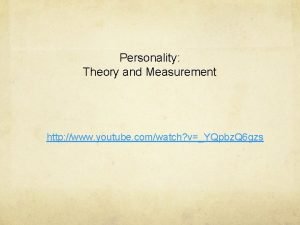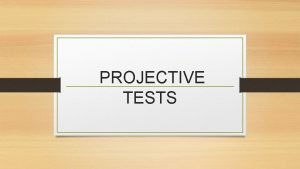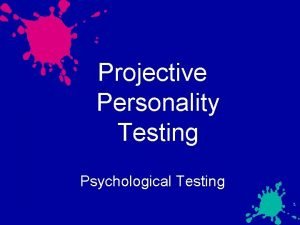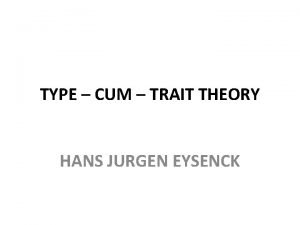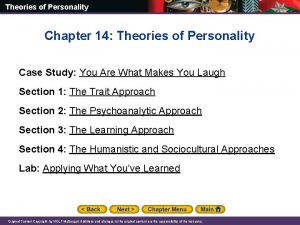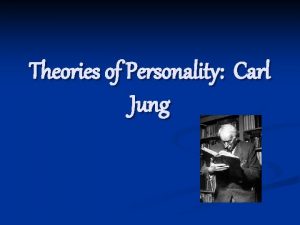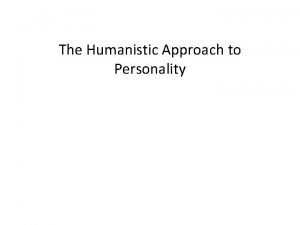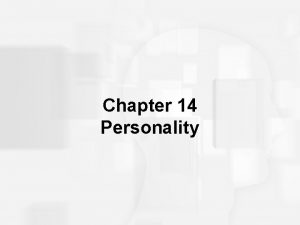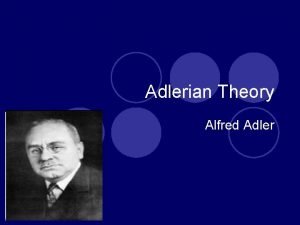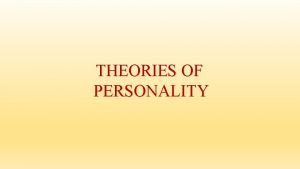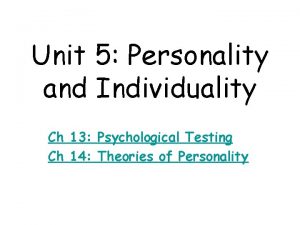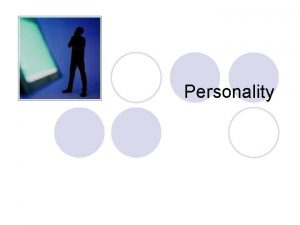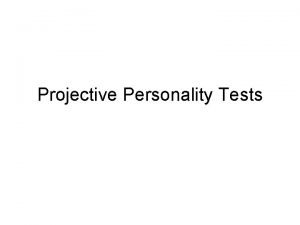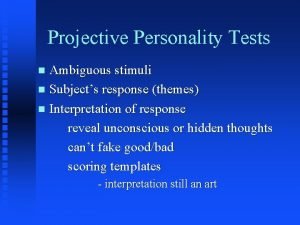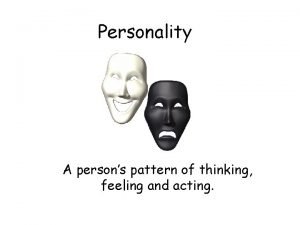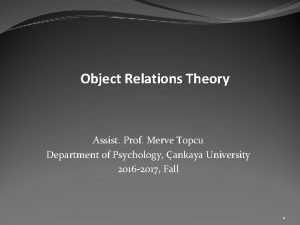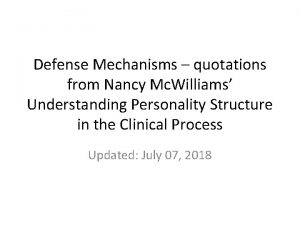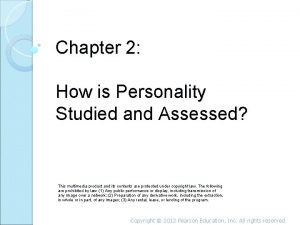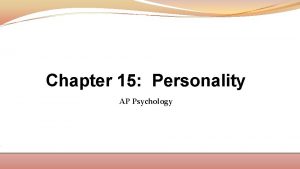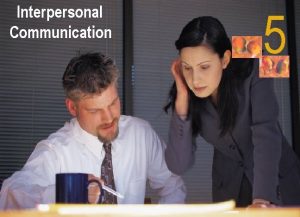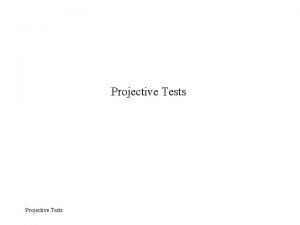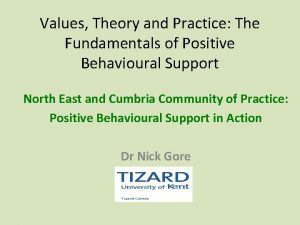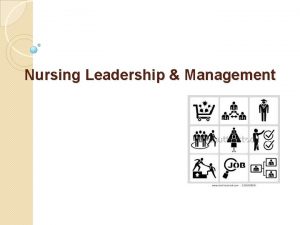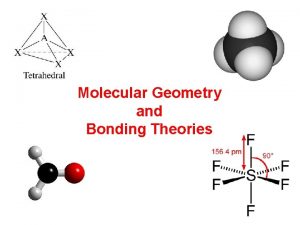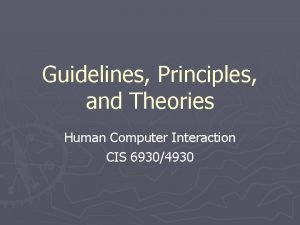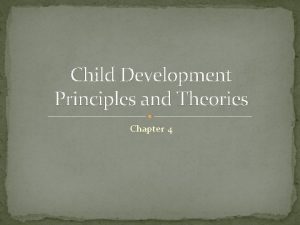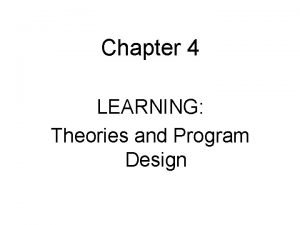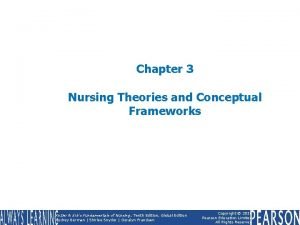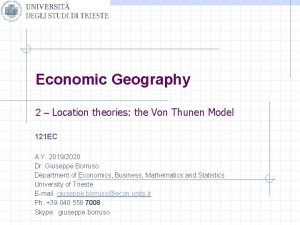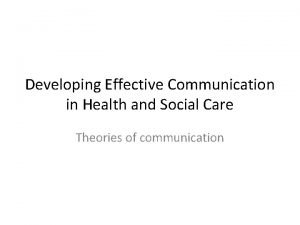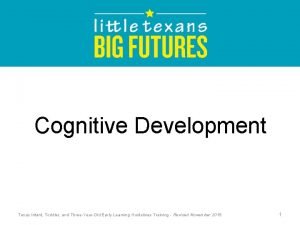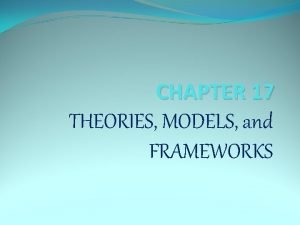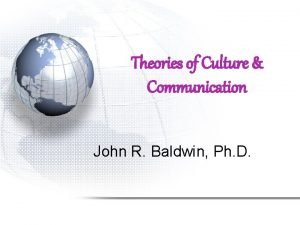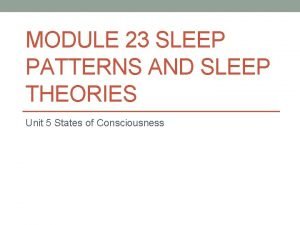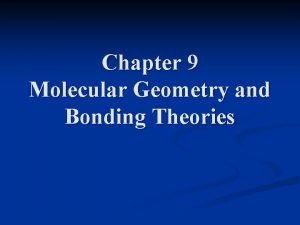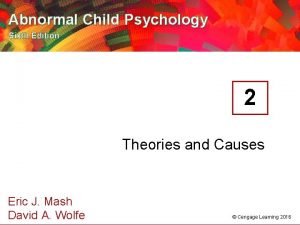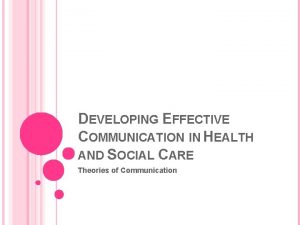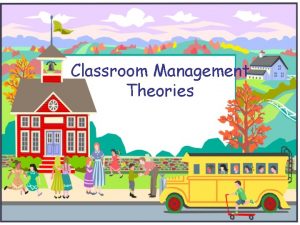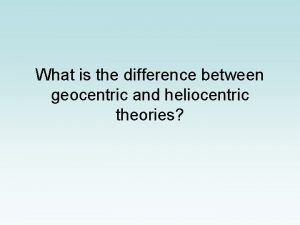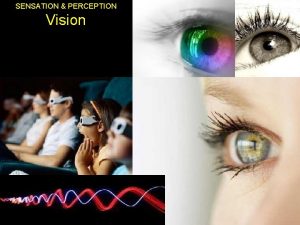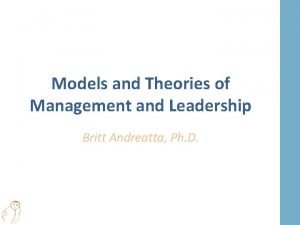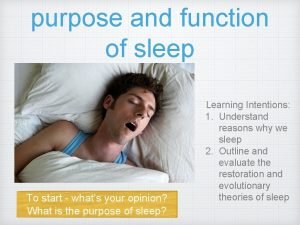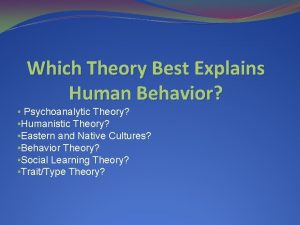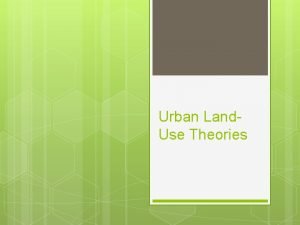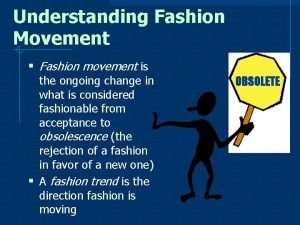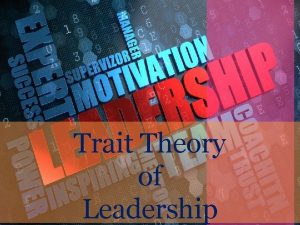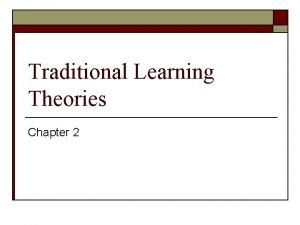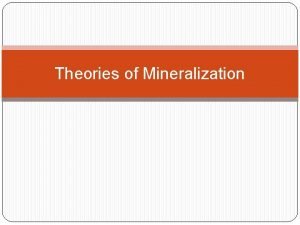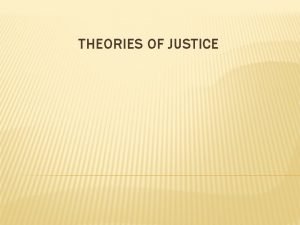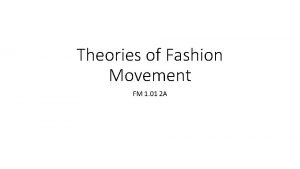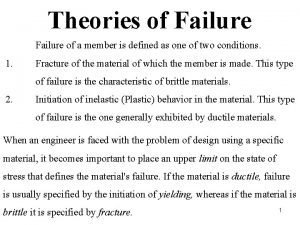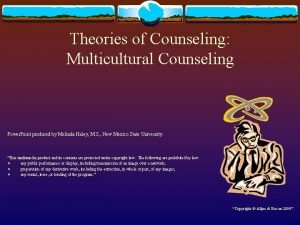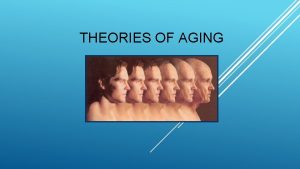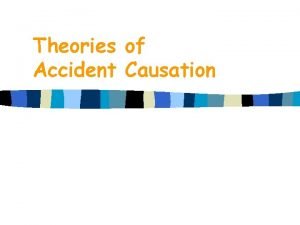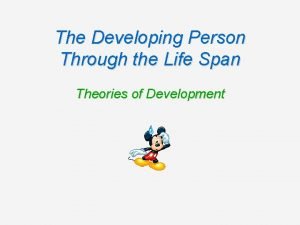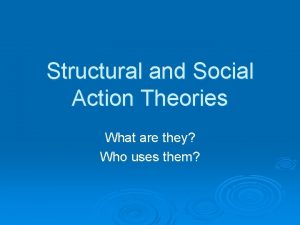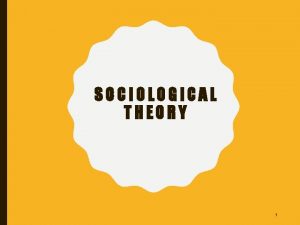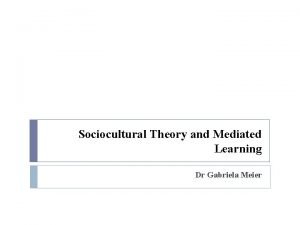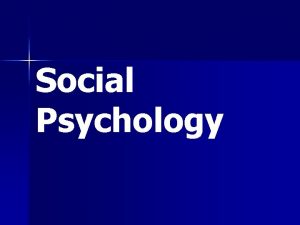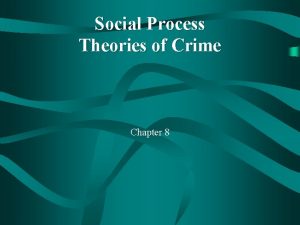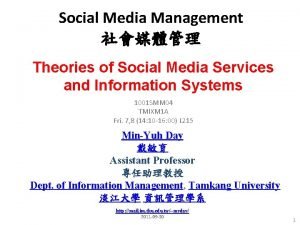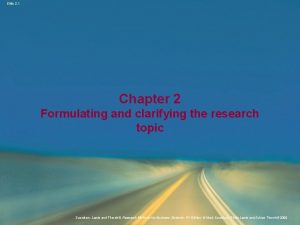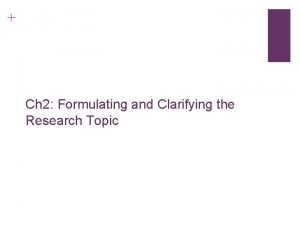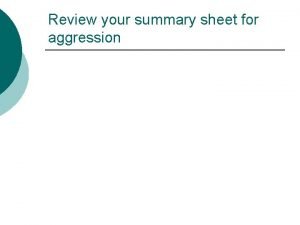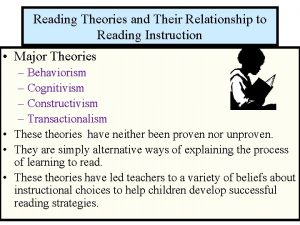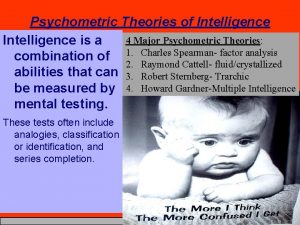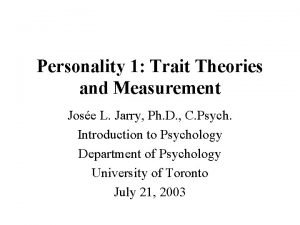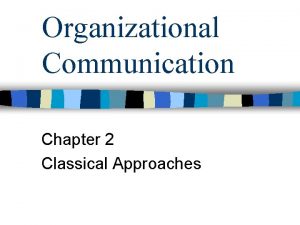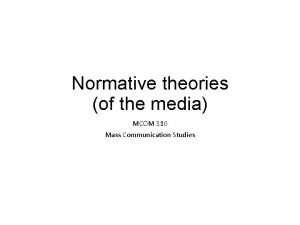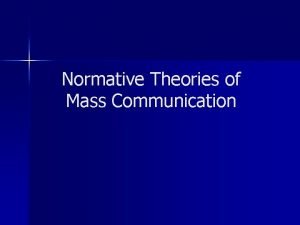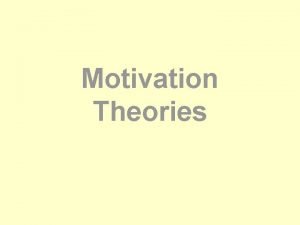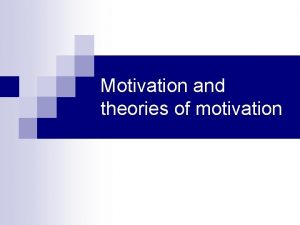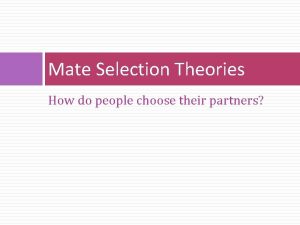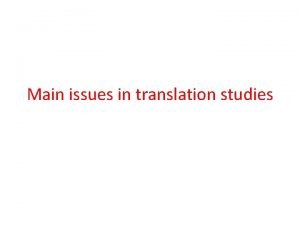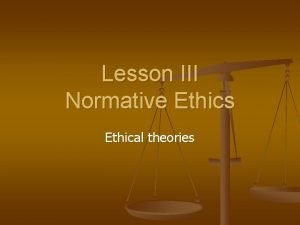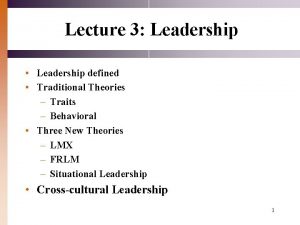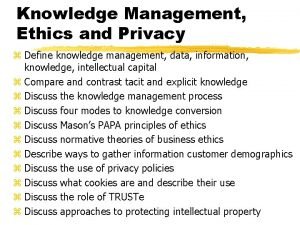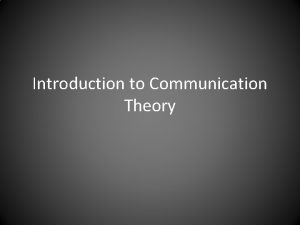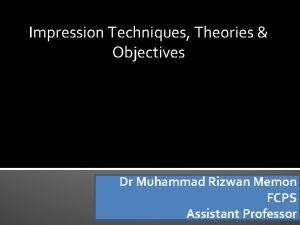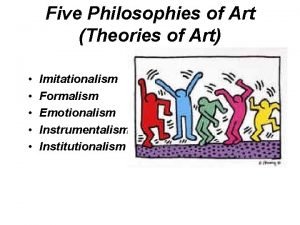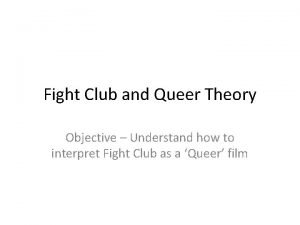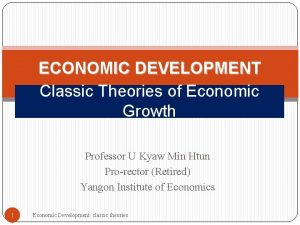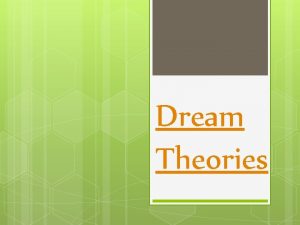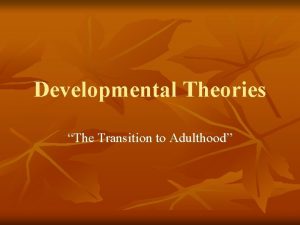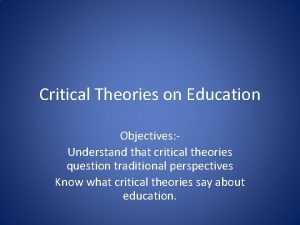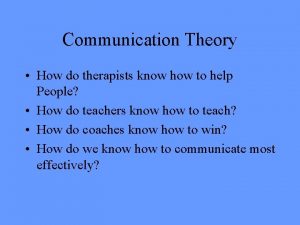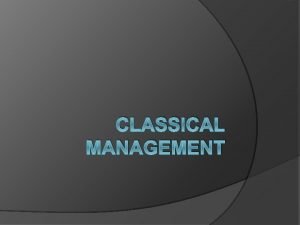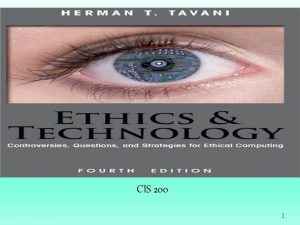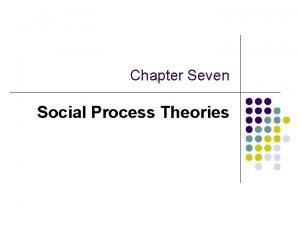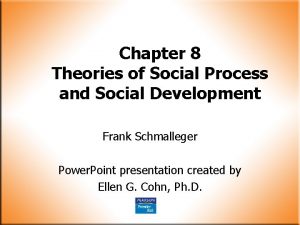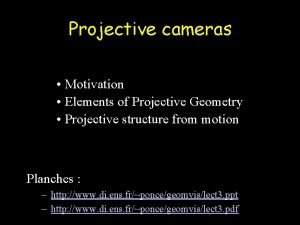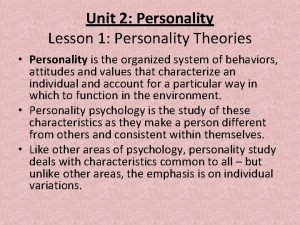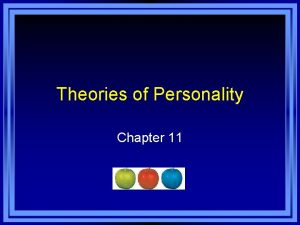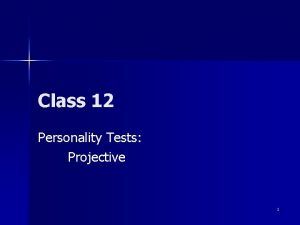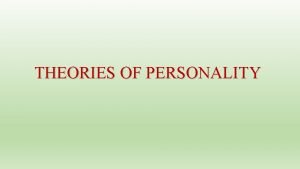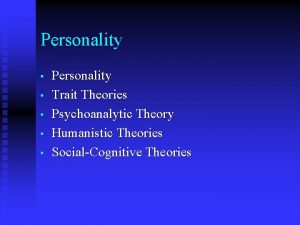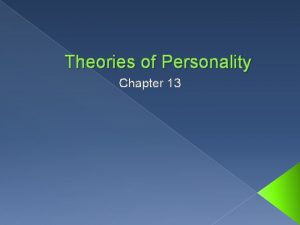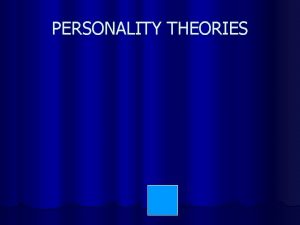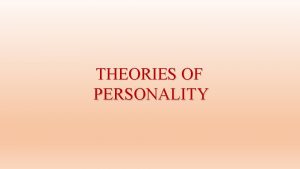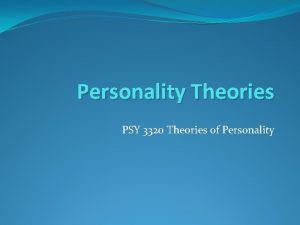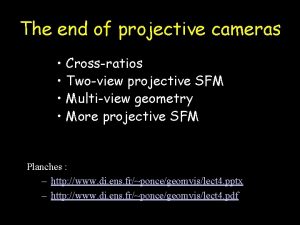Theories of Personality and Projective Technique 98114010 98114011




































































![Projective Hypothesis [page 326~page 327] • Projective method: To describe a category of tests Projective Hypothesis [page 326~page 327] • Projective method: To describe a category of tests](https://slidetodoc.com/presentation_image_h/c11f56f5f73617c2e13037e8f9ec2b49/image-69.jpg)
![Projective Hypothesis [page 326~page 327] Projective test: 1. Based on the projective hypothesis, and Projective Hypothesis [page 326~page 327] Projective test: 1. Based on the projective hypothesis, and](https://slidetodoc.com/presentation_image_h/c11f56f5f73617c2e13037e8f9ec2b49/image-70.jpg)
![A Classification of Projective Technique [page 327] Based on the response required, Lindzey (1959) A Classification of Projective Technique [page 327] Based on the response required, Lindzey (1959)](https://slidetodoc.com/presentation_image_h/c11f56f5f73617c2e13037e8f9ec2b49/image-71.jpg)



![The Rorschach (羅夏克墨漬測驗) [page 327] • There are 10 pictures: (black & gray)*5 + The Rorschach (羅夏克墨漬測驗) [page 327] • There are 10 pictures: (black & gray)*5 +](https://slidetodoc.com/presentation_image_h/c11f56f5f73617c2e13037e8f9ec2b49/image-75.jpg)
![The Rorschach (羅夏克墨漬測驗) [page 327 -page 328] There are two phases that the examiner The Rorschach (羅夏克墨漬測驗) [page 327 -page 328] There are two phases that the examiner](https://slidetodoc.com/presentation_image_h/c11f56f5f73617c2e13037e8f9ec2b49/image-76.jpg)
![The Rorschach (羅夏克墨漬測驗) [page 327 -page 328] • The free association phase: (自由聯想階段) E: The Rorschach (羅夏克墨漬測驗) [page 327 -page 328] • The free association phase: (自由聯想階段) E:](https://slidetodoc.com/presentation_image_h/c11f56f5f73617c2e13037e8f9ec2b49/image-77.jpg)
![The Rorschach (羅夏克墨漬測驗) [page 328] • The inquiry phase: (探索階段) E: (asks questions to The Rorschach (羅夏克墨漬測驗) [page 328] • The inquiry phase: (探索階段) E: (asks questions to](https://slidetodoc.com/presentation_image_h/c11f56f5f73617c2e13037e8f9ec2b49/image-78.jpg)
![The Rorschach (羅夏克墨漬測驗) [page 327 -page 328] ---How does the examiner code the examinee’s The Rorschach (羅夏克墨漬測驗) [page 327 -page 328] ---How does the examiner code the examinee’s](https://slidetodoc.com/presentation_image_h/c11f56f5f73617c2e13037e8f9ec2b49/image-79.jpg)

![The Rorschach (羅夏克墨漬測驗) [page 328] ---What do the codes represent? For example: F+ percent The Rorschach (羅夏克墨漬測驗) [page 328] ---What do the codes represent? For example: F+ percent](https://slidetodoc.com/presentation_image_h/c11f56f5f73617c2e13037e8f9ec2b49/image-81.jpg)
![The Rorschach (羅夏克墨漬測驗) [page 328 -page 330] • L. K. Frank : not enough The Rorschach (羅夏克墨漬測驗) [page 328 -page 330] • L. K. Frank : not enough](https://slidetodoc.com/presentation_image_h/c11f56f5f73617c2e13037e8f9ec2b49/image-82.jpg)
![The Rorschach (羅夏克墨漬測驗) [page 328 -page 330] Rorschach Prognostic Rating Scale (RPRS; Handler & The Rorschach (羅夏克墨漬測驗) [page 328 -page 330] Rorschach Prognostic Rating Scale (RPRS; Handler &](https://slidetodoc.com/presentation_image_h/c11f56f5f73617c2e13037e8f9ec2b49/image-83.jpg)
![The Rorschach (羅夏克墨漬測驗) [page 330] • Thought Disorder Index (TDI; Holtzman, Levy & Johnston) The Rorschach (羅夏克墨漬測驗) [page 330] • Thought Disorder Index (TDI; Holtzman, Levy & Johnston)](https://slidetodoc.com/presentation_image_h/c11f56f5f73617c2e13037e8f9ec2b49/image-84.jpg)
![The Rorschach (羅夏克墨漬測驗) [page 330] • Thought Disorder Index (TDI) 0 . 25 . The Rorschach (羅夏克墨漬測驗) [page 330] • Thought Disorder Index (TDI) 0 . 25 .](https://slidetodoc.com/presentation_image_h/c11f56f5f73617c2e13037e8f9ec2b49/image-85.jpg)
![Comment on the Rorschach [page 331] • Albert, Fox and Kahn: The results of Comment on the Rorschach [page 331] • Albert, Fox and Kahn: The results of](https://slidetodoc.com/presentation_image_h/c11f56f5f73617c2e13037e8f9ec2b49/image-86.jpg)
![Comment on the Rorschach [page 331] 24 persons 4 groups; 6 persons in each Comment on the Rorschach [page 331] 24 persons 4 groups; 6 persons in each](https://slidetodoc.com/presentation_image_h/c11f56f5f73617c2e13037e8f9ec2b49/image-87.jpg)
![Comment on the Rorschach [page 331] ---results: possibility of diagnosed psychotics • paranoid schizophrenia Comment on the Rorschach [page 331] ---results: possibility of diagnosed psychotics • paranoid schizophrenia](https://slidetodoc.com/presentation_image_h/c11f56f5f73617c2e13037e8f9ec2b49/image-88.jpg)

![Sentence Completion Test [page 332] • Gives only first few words, examinee has to Sentence Completion Test [page 332] • Gives only first few words, examinee has to](https://slidetodoc.com/presentation_image_h/c11f56f5f73617c2e13037e8f9ec2b49/image-90.jpg)
![Sentence Completion Test [page 332] ---Can be interpreted in two ways: • Subjective-intuitive analysis Sentence Completion Test [page 332] ---Can be interpreted in two ways: • Subjective-intuitive analysis](https://slidetodoc.com/presentation_image_h/c11f56f5f73617c2e13037e8f9ec2b49/image-91.jpg)
![Sentence Completion Test [page 332] • There are many sentence completion test. →Table 8. Sentence Completion Test [page 332] • There are many sentence completion test. →Table 8.](https://slidetodoc.com/presentation_image_h/c11f56f5f73617c2e13037e8f9ec2b49/image-92.jpg)
![Rotter Incomplete Sentence Blank 盧特語句完成測驗)[page 332] • RISB includes 3 similar forms: 1. High Rotter Incomplete Sentence Blank 盧特語句完成測驗)[page 332] • RISB includes 3 similar forms: 1. High](https://slidetodoc.com/presentation_image_h/c11f56f5f73617c2e13037e8f9ec2b49/image-93.jpg)
![Rotter Incomplete Sentence Blank ( 盧特語句完成測驗)[page 333] The objective scoring system: Response Score Example Rotter Incomplete Sentence Blank ( 盧特語句完成測驗)[page 333] The objective scoring system: Response Score Example](https://slidetodoc.com/presentation_image_h/c11f56f5f73617c2e13037e8f9ec2b49/image-94.jpg)
![Rotter Incomplete Sentence Blank ( 盧特語句完成測驗)[page 333] Score: 0 x Sentences: 40 6 x Rotter Incomplete Sentence Blank ( 盧特語句完成測驗)[page 333] Score: 0 x Sentences: 40 6 x](https://slidetodoc.com/presentation_image_h/c11f56f5f73617c2e13037e8f9ec2b49/image-95.jpg)
![Rotter Incomplete Sentence Blank 盧特語句完成測驗)[page 333] The reliability is good: • Interscorer reliability→. 90 Rotter Incomplete Sentence Blank 盧特語句完成測驗)[page 333] The reliability is good: • Interscorer reliability→. 90](https://slidetodoc.com/presentation_image_h/c11f56f5f73617c2e13037e8f9ec2b49/image-96.jpg)
![Rotter Incomplete Sentence Blank 盧特語句完成測驗)[page 333] ---Can screen out people with maladjustment: For example: Rotter Incomplete Sentence Blank 盧特語句完成測驗)[page 333] ---Can screen out people with maladjustment: For example:](https://slidetodoc.com/presentation_image_h/c11f56f5f73617c2e13037e8f9ec2b49/image-97.jpg)















































- Slides: 144

Theories of Personality and Projective Technique 第二組 98114010 凌翊涵 98114011 郭昀昕 98114026 曾詩宴 98114032 蔡宛蓁 98114035 陳宜廷 98114036 戴培瑜

Ability Tests: 1. measuring intelligence 2. achievement 3. aptitude Personality Tests: 1. personality traits 2. dynamic motivation 3. symptoms of distress 4. personal strengths 5. attitudinal characteristics P. 314

An Overview P. 315 Two fundamental features: 1. consistent extent:coherent traits and action patterns 2. distinctive extent:behavioral differences exist between individuals For example:if they get B… Mary:complain Amy:pleased Maria:disappointed but stoical : |

the concept of personality : 1. make sense out of the behavior and express feelings of others 2. explain behavioral differences between persons (Mary and Maria) 3. understand the behavioral consistency within individuals(Mary:sour and disappointed)

*Personality’s Attribute: 1. Globality 2. Stability 3. Individuality 4. Motivity & Adaptability 5. Nature & Sociality personality: character、belief、notion of self

P. 316 Origins of Psychoanalytic Theory *Sigmund Freud(1856, Moravian): 1. psychiatrist of Austria 2. founder of psychoanalysis study 3. Joesph Breuer:hysteria, by Talking Out 4. Jean-Martin Charcot:hypnosis treatment 5. self-analysis method:because of the sex 6. analysis of the dream

hypnosis treatment

Hysteria:(out of control) 1. an emotional disorder characterized by histrionic behavior and physical symptoms of psychic origin 2. a buried memories of traumatic experiences

hysteria

Unconscious:(you don’t know) 1. the reservoir of instinctual drives and a storehouse of thoughts 2. unacceptable to our conscious self 3. The Interpretation of Dreams(1990)

People know conscious preconscious unconscious

Dreams: 1. dreams portray our unconscious motives in a disguised form 2. have a hidden sexual or aggressive meanings

Projective techniques: 1. inkblot tests 2. word association approaches 3. sentence completion techniques 4. storytelling techniques(apperception)

The Structure of the Mind THE ID: 1. entirely unconscious 2. instinctual needs 3. pleasure principle P. 316

emperor

THE SUPEREGO: 1. ethical component 2. restrict the attempts of the id and the ego to obtain gratification 3. ego ideal

Buddha

THE EGO: 1. largely conscious 2. mediate between the id and the reality 3. reality principle

P. 317 The Role of Defense Mechanisms 1. help the ego reduce anxiety 2. operate unconsciously 3. distort inner or outer reality

Assessment of Defense Mechanisms P. 317 and Ego Functions Vaillant(according to the psychological maturity classification) 1. psychotic 2. immature 3. neurotic 4. mature

P. 318 Psychotic: 1. the least healthy because they distort reality to an extreme degree 2. appear crazy EX: 1. Delusional Projection 2. Denial 3. Distortion

Immature: P. 318 1. are easily detected by outside observers 2. seen as undesirable EX: 1. Projection 2. Schizoid Fantasy 3. Hypochondriasis 4. Passive-Aggressive Behavior 5. Acting Out

P. 318 Neurotic: 1. alter private feelings so that they are less threatening EX: 1. Intellectualization 2. Repression 3. Displacement 4. Reaction Formation 5. Dissociation

Mature: 1. convenient virtues EX: 1. Altruism 2. Humor 3. Suppression 4. Anticipation 5. Sublimation P. 318

P. 319 Sum: 1. validity ratings:developmental changes and group differences 2. use fewer immature and more mature defense mechanisms as they grow into middle age Drawback: 1. need specialized training 2. time-consuming

P. 319 Type Theories of Personality 1. the Greek physician Hippocrates: sanguine(happy)、choleric(angry)、 melancholic(blue)、phlegmatic(cold) 2. Sheldon and Stevens

Type A Coronary-Prone Behavior Pattern P. 319 1. Friedman and Rosenman(1974):put individuals at higher risk of coronary heart disease 2. emotion complex 3. against the opposing efforts of others things or persons 4. the Type B behavior pattern:easygoing、 noncompetitive、relaxed lifestyle

Friedman and Ulmer(1984)have listed the specific components of the full-fledged Type A behavior pattern: 1. Insecurity of status 2. Hyperaggressiveness 3. Free-floating hostility 4. Sense of time urgency(hurry sickness)

Insecurity of status: P. 319 A hidden lack of self-esteem seems to plague many Type A persons. No matter how successful, they often compare themselves unfavorably to other superachievers.

Hyperaggressiveness: P. 319 A desire to dominate others and damage their self-esteem is part of the pattern. Type A persons are often indifferent to the feelings or rights of competitors.

Free-floating hostility: P. 319 The Type A person finds too many things to get upset about, and the anger is out of proportion to the situation.

Sense of time urgency(hurry sickness): P. 319 This includes two basic strategems, speeding up daily activities, and doing two things at once.

* being irritable、lack of patience、the rude language、easily to be enraged、suspect but stand the long-term work、depend on excessive drugs、ignore the healthy risk 1. depressing personality 2. high defense 3. high social anticipation 4. urgency

*Play with me examine and detect if you are a Type A or not: Type A coronary-prone behavior pattern http: //hospital. kingnet. com. tw/heartsustain/b -4. html

P. 320 Type A behavior can be diagnosed from a short interview. It can also be detected by paper-and-pencil test. However, the questionnaire approach is limited. (no facial, vocal, hostility, time urgency)

Early studies indicated that persons who exhibited the Type A behavior pattern were at greatly increased risk of coronary disease and heart attack. In fact, not one of the pure Type Bs had suffered a heart attack. In other studies, researchers have found only a weak -or no relationship at all- between Type A behavior and coronary heart disease.

P. 320 Wielgosz and Nolan(2000) identify hostility, cynicism, and suppression of anger, as well as stress, depression, and social isolation, as significant risk factors in Type A behavior.

Phenomenological theories of personality immediate ※Emphasize the importance of personal experiences. subjective ※Originated with the German philosopher Husserl. the Danish existential writer Kierkegaard. Husserl phenomenology Existentialism 存在主義 Kierkegaard Origins of the Phenomenological Approach p. 320

What is Q-sort? Q-technique was developed by Stephenson. I invented the Q-sort to measure the self-concept and the idle self. Carl Rogers Q-sort is especially useful for studying changes in self-concept . More details Carl Rogers, Self-Theory, and the Q-Technique P. 320 p. 321

The procedure of Q-Technique The subject is given a hundred (or so) of cards The cards may contain self-referent statements. The subject’s task is to sort the cards into 9 categories. most like me least like me →Forcing a near-normal distribution. Carl Rogers, Self-Theory, and the Q-Technique p. 321


Self sort and ideal-sort Sort the items twice: (1)Self sort (2)Ideal-sort Carl Rogers, Self-Theory, and the Q-Technique p. 321

治療前 治療後 後續追蹤 Precounseli Postcounseli Follow-Up ng ng 實驗組 Client Group -0. 10 0. 36 0. 32 控制� 0. 58 —— 0. 59 Control Group ◎The self-sort and the ideal sort are highly similar in Control and this result is not change over time. Group, Psychotherapy clients increases their congruence between self and ideal. Carl Rogers, Self-Theory, and the Q-Technique P. 322 TABLE 8. 2

BEHAVIORAL AND SOCIAL LEARNING THEORIES ◎Early in 20 century Modern social learning theory behaviorism BEHAVIORAL AND SOCIAL LEARNING THEORIES P. 322

BEHAVIORAL AND SOCIAL LEARNING THEORIES ※Behavioral theorists: Learned / environment / Disagree cognitions When what a person does is attributed to what is going on inside of him, investigation is brought to an end. Skinner ※Social learning theorists Reference to cognitions We learn expectations or rules about the environment, not just stimulus and response connections! BEHAVIORAL AND SOCIAL LEARNING THEORIES P. 322

BEHAVIORAL AND SOCIAL LEARNING THEORIES ◎behavioral and social learning = personality are learned. sees no role for ognitions in explaining behavior. Rotter radical behavior theorist (基本教義派) In Contrast -Skinner environmental reinforces are the primary determinants of behavior. lower left P. 322

BEHAVIORAL AND SOCIAL LEARNING THEORIES ü(1) External reinforcement is an important determinant of behavior ü(2) Cognitions have a critical influence in our actions. →Based on (1)(2), Rotter developed the Internal-External(I-E) Scale :*內外控量表 ※Rotter‘s view : Behavior was largely guided by "reinforcements“ ※Locus of control(內外控傾向) See the details next page lower right P. 322

Your Locus of control (內外控傾向) is…. . ? ? Do you believe that your destiny is controlled by yourself or by external forces ? External Locus of Control Internal Locus of Control behaviour is guided by fate, luck, or other external circumstances behaviour is guided by his/her personal decisions and efforts. BEHAVIORAL AND SOCIAL LEARNING THEORIES Upper Left of p. 323

rush answer time! Discuss with your partner: Internal or external?

Self-efficacy Albert bandura: -Person’s belief about his or her ability and capacity to accomplish a task or to deal with the challenges of life. -different from confidence. lower left of P. 323

BEHAVIORAL AND SOCIAL LEARNING THEORIES Dear diary, sorry to bother you again. See the Exercise of Self-efficacy Scale lower left of P. 323

Trait conceptions of personality -Outline. Definition Cattell’s Factor-Analytic Trait Theory (16 PF) Eysenck’s Trait-Dimensional Theory (PEN) The Five-Factor Model of Personality (BIG FIVE) Comment on the Trait Concept

Trait conceptions of personality How do you introduce yourself?

Trait conceptions of personality -Definition- What is 〝 Trait 〞? A trait is any relatively enduring way in which one individual differs from another. The ways people describe other people in everyday life. 1. stable over time 2. stable across situations

Trait conceptions of personality -Cattell’s Factor-Analytic Trait Theory◎ used factor analysis to help reveal the basic traits of personality. Raymond B. Cattell (1905 -1998)

Factor analysis: 1) Derives source traits from surface traits. 2) Summarizes large data sets with a few dimensions. 3) Dimensions are called factors & represent intercorrelations among multiple personality traits. http: //www. utdallas. edu/~kprager/trait. htm

Cattell’s Factor-Analytic Trait Theory -Aspects of personality- Surface traits Source traits • are easily observable clusters of behavior. • Surface traits should group together under larger source traits. • are underlying. Basic building blocks of personality. • Less visible than surface traits but are more important in accounting for behavior. Discovery of source traits is the most important goal.

Cattell’s success Use Factor analysis to find how traits were organized and how they were related to each other. two ways: 1. have persons rate others they knew well by checking adjectives. 2. have thousands of persons answer questions about themselves and then factor-analyze their responses. 16 Personality Factors (16 PF)


Trait conceptions of personality -Eysenck’s Trait-Dimensional Theory- used factor analysis to put a modern face of the four temperaments. Hans J. Eysenck(1975)

Melancholic (憂鬱) Choleric (易怒) Phlegmatic (鎮定) Sanguine (樂觀) The Two-Dimensional Classification of personality

Eysenck’s Trait-Dimensional Theory -PENPsychoticism(精神病質) Aggressive, cold, egocentric… Extraversion(外向的): Sociable, lively, active, assertive… Neuroticism(神經質): Anxious, depressed, low self-esteem, moody…

Trait conceptions of personality -The Five-Factor Model of Personality- fundamental lexical hypothesis(1981) Lewis R. Goldberg


Five dimensions of personality(OCEAN): Neuroticism-Being anxious, moody Extraversion-Being outgoing, sociable Openness to Experience-Being curious, creative, and open to new ideas Agreeableness-Being affable, warm, kind Conscientiousness-Being organized, systematic, punctual

Scales from BIG FIVEp. 326 Founder: Costa and Mc. Crae Two personality tests based on the five -factor model: 1. The Revised NEO Personality Inventory (NEO-PI-R) 2. The NEO Five-Factor Inventory (NEO-FFI)

Comment on the Trait Concept 1. Traits cause behavior VS. Traits merely describe behavior 2. low predictive validity

The Projective Hypothesis (投射假說) 昀昕
![Projective Hypothesis page 326page 327 Projective method To describe a category of tests Projective Hypothesis [page 326~page 327] • Projective method: To describe a category of tests](https://slidetodoc.com/presentation_image_h/c11f56f5f73617c2e13037e8f9ec2b49/image-69.jpg)
Projective Hypothesis [page 326~page 327] • Projective method: To describe a category of tests for studying personality with unstructured stimuli. (非結構性刺激) • Projective hypothesis: Personal interpretations of ambiguous stimuli must necessarily reflect the unconscious needs, motives and conflicts of the examinee. Bonus+ Bonus+ structured stimuli: a set of questions, forms, scales…etc. unstructured stimuli: pictures, sentences, a piece of blank paper…etc.
![Projective Hypothesis page 326page 327 Projective test 1 Based on the projective hypothesis and Projective Hypothesis [page 326~page 327] Projective test: 1. Based on the projective hypothesis, and](https://slidetodoc.com/presentation_image_h/c11f56f5f73617c2e13037e8f9ec2b49/image-70.jpg)
Projective Hypothesis [page 326~page 327] Projective test: 1. Based on the projective hypothesis, and use projective method. 2. Conduct individually. 3. The responses of each examinee are unique and subjective.
![A Classification of Projective Technique page 327 Based on the response required Lindzey 1959 A Classification of Projective Technique [page 327] Based on the response required, Lindzey (1959)](https://slidetodoc.com/presentation_image_h/c11f56f5f73617c2e13037e8f9ec2b49/image-71.jpg)
A Classification of Projective Technique [page 327] Based on the response required, Lindzey (1959) divided projectives into five category: • Association to inkblots or words(墨漬連結) • Completions of sentences or stories(語句完成) • Construction of stories or sequences(統覺故事 ) • Arrangement/selection of pictures or verbal choices Ex: Szondi test [page 64] • Expression with drawing or play(繪畫表達)

The classification in this chapter • Association Techniques • Completion Techniques • Construction Techniques • Expression Techniques

Association Techniques

The Rorschach (羅夏克墨漬測驗) • Herman Rorschach(18841922): A psychiatrist from Switzerland • It’s suited to person age 5 and up but is most commonly used with adults. [page 327]
![The Rorschach 羅夏克墨漬測驗 page 327 There are 10 pictures black gray5 The Rorschach (羅夏克墨漬測驗) [page 327] • There are 10 pictures: (black & gray)*5 +](https://slidetodoc.com/presentation_image_h/c11f56f5f73617c2e13037e8f9ec2b49/image-75.jpg)
The Rorschach (羅夏克墨漬測驗) [page 327] • There are 10 pictures: (black & gray)*5 + (black, gray & red)*2 + (colored)*3 • The pictures are relatively symmetrical(對稱) bilateral(雙邊). 10 pictures of The Rorschach
![The Rorschach 羅夏克墨漬測驗 page 327 page 328 There are two phases that the examiner The Rorschach (羅夏克墨漬測驗) [page 327 -page 328] There are two phases that the examiner](https://slidetodoc.com/presentation_image_h/c11f56f5f73617c2e13037e8f9ec2b49/image-76.jpg)
The Rorschach (羅夏克墨漬測驗) [page 327 -page 328] There are two phases that the examiner (E) asks the examinee (e) questions: • The free association phase ( 自由聯想階段) • The inquiry phase(探索階段)
![The Rorschach 羅夏克墨漬測驗 page 327 page 328 The free association phase 自由聯想階段 E The Rorschach (羅夏克墨漬測驗) [page 327 -page 328] • The free association phase: (自由聯想階段) E:](https://slidetodoc.com/presentation_image_h/c11f56f5f73617c2e13037e8f9ec2b49/image-77.jpg)
The Rorschach (羅夏克墨漬測驗) [page 327 -page 328] • The free association phase: (自由聯想階段) E: “What might this picture be? ” e: “Should I use the whole blot or part of it? ” E: “It’s up to you!” e: (might give more than one response)
![The Rorschach 羅夏克墨漬測驗 page 328 The inquiry phase 探索階段 E asks questions to The Rorschach (羅夏克墨漬測驗) [page 328] • The inquiry phase: (探索階段) E: (asks questions to](https://slidetodoc.com/presentation_image_h/c11f56f5f73617c2e13037e8f9ec2b49/image-78.jpg)
The Rorschach (羅夏克墨漬測驗) [page 328] • The inquiry phase: (探索階段) E: (asks questions to clarify the exact blot location) e: (might give responses about the form, color, or movement…etc. ) E: (codes the responses)
![The Rorschach 羅夏克墨漬測驗 page 327 page 328 How does the examiner code the examinees The Rorschach (羅夏克墨漬測驗) [page 327 -page 328] ---How does the examiner code the examinee’s](https://slidetodoc.com/presentation_image_h/c11f56f5f73617c2e13037e8f9ec2b49/image-79.jpg)
The Rorschach (羅夏克墨漬測驗) [page 327 -page 328] ---How does the examiner code the examinee’s response? • Rorschach died early, he hadn’t finish a scoring system. • Exner(1993) and his colleagues synthesized the comprehensive scoring system: See it on the next page!

Location (位置) W D Dd S Form (形狀) Form+ (完全貼切) Form- (不大貼切) Movement (動作) Color (顏色) Texture (質地) Content (內容) H Hd Ex Xy What features determined the response? What was the percept? Human (人) Human detail (軀幹) Explosion (爆發) X-ray (透視) Popular vs. Original (稀有性) P O Where was the percept located? Whole (全部) Common detail (共同細節) Unusual detail (不尋常細節) Space (空白) Determinant (決定因素) F F+ FM C T [page 329] Popular (普遍) Original (稀有) Was the response common or rare? See more in Wiki…
![The Rorschach 羅夏克墨漬測驗 page 328 What do the codes represent For example F percent The Rorschach (羅夏克墨漬測驗) [page 328] ---What do the codes represent? For example: F+ percent](https://slidetodoc.com/presentation_image_h/c11f56f5f73617c2e13037e8f9ec2b49/image-81.jpg)
The Rorschach (羅夏克墨漬測驗) [page 328] ---What do the codes represent? For example: F+ percent • F+ percentage↓ 70%: psychopathology • ego strength: examinee with high score can deal with stress well.
![The Rorschach 羅夏克墨漬測驗 page 328 page 330 L K Frank not enough The Rorschach (羅夏克墨漬測驗) [page 328 -page 330] • L. K. Frank : not enough](https://slidetodoc.com/presentation_image_h/c11f56f5f73617c2e13037e8f9ec2b49/image-82.jpg)
The Rorschach (羅夏克墨漬測驗) [page 328 -page 330] • L. K. Frank : not enough for the diagnosis of schizophrenia(精神分裂症). • Bornstein and Masling : The comprehensive scoring system (by Exner) Should not confuse The Rorschach (by Rorschach)
![The Rorschach 羅夏克墨漬測驗 page 328 page 330 Rorschach Prognostic Rating Scale RPRS Handler The Rorschach (羅夏克墨漬測驗) [page 328 -page 330] Rorschach Prognostic Rating Scale (RPRS; Handler &](https://slidetodoc.com/presentation_image_h/c11f56f5f73617c2e13037e8f9ec2b49/image-83.jpg)
The Rorschach (羅夏克墨漬測驗) [page 328 -page 330] Rorschach Prognostic Rating Scale (RPRS; Handler & Clemence): To predict the psychotherapy for the examiner will be successful or not. -12 -6 A hopeless case. -2 2 50 -50 chance. 7 13 +17 The person is able to help himself.
![The Rorschach 羅夏克墨漬測驗 page 330 Thought Disorder Index TDI Holtzman Levy Johnston The Rorschach (羅夏克墨漬測驗) [page 330] • Thought Disorder Index (TDI; Holtzman, Levy & Johnston)](https://slidetodoc.com/presentation_image_h/c11f56f5f73617c2e13037e8f9ec2b49/image-84.jpg)
The Rorschach (羅夏克墨漬測驗) [page 330] • Thought Disorder Index (TDI; Holtzman, Levy & Johnston) • Thought disorder is especially characteristic of patients with schizophrenia. mild slippage continuum bizarre disorganization See more…
![The Rorschach 羅夏克墨漬測驗 page 330 Thought Disorder Index TDI 0 25 The Rorschach (羅夏克墨漬測驗) [page 330] • Thought Disorder Index (TDI) 0 . 25 .](https://slidetodoc.com/presentation_image_h/c11f56f5f73617c2e13037e8f9ec2b49/image-85.jpg)
The Rorschach (羅夏克墨漬測驗) [page 330] • Thought Disorder Index (TDI) 0 . 25 . 50 . 75 1. 0 extreme none x 100 0 none response is strange 100 every response is strange
![Comment on the Rorschach page 331 Albert Fox and Kahn The results of Comment on the Rorschach [page 331] • Albert, Fox and Kahn: The results of](https://slidetodoc.com/presentation_image_h/c11f56f5f73617c2e13037e8f9ec2b49/image-86.jpg)
Comment on the Rorschach [page 331] • Albert, Fox and Kahn: The results of the Rorschach might easily be fake. • The made up a 24 persons group.
![Comment on the Rorschach page 331 24 persons 4 groups 6 persons in each Comment on the Rorschach [page 331] 24 persons 4 groups; 6 persons in each](https://slidetodoc.com/presentation_image_h/c11f56f5f73617c2e13037e8f9ec2b49/image-87.jpg)
Comment on the Rorschach [page 331] 24 persons 4 groups; 6 persons in each group • paranoid schizophrenia patients • Uninformed fakers • Informed fakers • Normal controls
![Comment on the Rorschach page 331 results possibility of diagnosed psychotics paranoid schizophrenia Comment on the Rorschach [page 331] ---results: possibility of diagnosed psychotics • paranoid schizophrenia](https://slidetodoc.com/presentation_image_h/c11f56f5f73617c2e13037e8f9ec2b49/image-88.jpg)
Comment on the Rorschach [page 331] ---results: possibility of diagnosed psychotics • paranoid schizophrenia patients: 48% • Uninformed fakers: 46% • Informed fakers: 72% • Normal controls: 24% Low reliability!

Completion Techniques
![Sentence Completion Test page 332 Gives only first few words examinee has to Sentence Completion Test [page 332] • Gives only first few words, examinee has to](https://slidetodoc.com/presentation_image_h/c11f56f5f73617c2e13037e8f9ec2b49/image-90.jpg)
Sentence Completion Test [page 332] • Gives only first few words, examinee has to complete the sentence. • Reflects the underlying motivations, attitudes, conflicts and fears. • Figure 8. 3→ I, mother, father
![Sentence Completion Test page 332 Can be interpreted in two ways Subjectiveintuitive analysis Sentence Completion Test [page 332] ---Can be interpreted in two ways: • Subjective-intuitive analysis](https://slidetodoc.com/presentation_image_h/c11f56f5f73617c2e13037e8f9ec2b49/image-91.jpg)
Sentence Completion Test [page 332] ---Can be interpreted in two ways: • Subjective-intuitive analysis (主觀直覺分析): projections from the responses • Objective analysis(客觀分析): means of scores
![Sentence Completion Test page 332 There are many sentence completion test Table 8 Sentence Completion Test [page 332] • There are many sentence completion test. →Table 8.](https://slidetodoc.com/presentation_image_h/c11f56f5f73617c2e13037e8f9ec2b49/image-92.jpg)
Sentence Completion Test [page 332] • There are many sentence completion test. →Table 8. 4 • Most of them are unpublished and unstandardized.
![Rotter Incomplete Sentence Blank 盧特語句完成測驗page 332 RISB includes 3 similar forms 1 High Rotter Incomplete Sentence Blank 盧特語句完成測驗)[page 332] • RISB includes 3 similar forms: 1. High](https://slidetodoc.com/presentation_image_h/c11f56f5f73617c2e13037e8f9ec2b49/image-93.jpg)
Rotter Incomplete Sentence Blank 盧特語句完成測驗)[page 332] • RISB includes 3 similar forms: 1. High school 2. College 3. Adult • Each contains 40 sentences. (
![Rotter Incomplete Sentence Blank 盧特語句完成測驗page 333 The objective scoring system Response Score Example Rotter Incomplete Sentence Blank ( 盧特語句完成測驗)[page 333] The objective scoring system: Response Score Example](https://slidetodoc.com/presentation_image_h/c11f56f5f73617c2e13037e8f9ec2b49/image-94.jpg)
Rotter Incomplete Sentence Blank ( 盧特語句完成測驗)[page 333] The objective scoring system: Response Score Example Omission (遺漏) 0 Conflict response 4 -6 (衝突作答) Positive response 0 -2 (正向作答) Neutral response 0 (中性作答) I hate … the entire world. 我恨全世界) The best…is yet to come. 最好的還在後頭) Most girls… are women. 大多數的女生是女人) ( ( (
![Rotter Incomplete Sentence Blank 盧特語句完成測驗page 333 Score 0 x Sentences 40 6 x Rotter Incomplete Sentence Blank ( 盧特語句完成測驗)[page 333] Score: 0 x Sentences: 40 6 x](https://slidetodoc.com/presentation_image_h/c11f56f5f73617c2e13037e8f9ec2b49/image-95.jpg)
Rotter Incomplete Sentence Blank ( 盧特語句完成測驗)[page 333] Score: 0 x Sentences: 40 6 x 40 = = Range of scores: 0 240 Maladjustment (失調; 不適應)
![Rotter Incomplete Sentence Blank 盧特語句完成測驗page 333 The reliability is good Interscorer reliability 90 Rotter Incomplete Sentence Blank 盧特語句完成測驗)[page 333] The reliability is good: • Interscorer reliability→. 90](https://slidetodoc.com/presentation_image_h/c11f56f5f73617c2e13037e8f9ec2b49/image-96.jpg)
Rotter Incomplete Sentence Blank 盧特語句完成測驗)[page 333] The reliability is good: • Interscorer reliability→. 90 s • Split-half coefficients→. 80 s (
![Rotter Incomplete Sentence Blank 盧特語句完成測驗page 333 Can screen out people with maladjustment For example Rotter Incomplete Sentence Blank 盧特語句完成測驗)[page 333] ---Can screen out people with maladjustment: For example:](https://slidetodoc.com/presentation_image_h/c11f56f5f73617c2e13037e8f9ec2b49/image-97.jpg)
Rotter Incomplete Sentence Blank 盧特語句完成測驗)[page 333] ---Can screen out people with maladjustment: For example: Score of 135 • Delinquent youth→ 60% • Heavy drug user→ 80%-100% (

Construction Technique (p 334) Thematic Apperception Test (主題統覺測驗) The Picture Projective Test (圖片投射測驗) Children’s Apperception Test (兒童主題統覺測驗) Other Variation on TAT

The Thematic Apperception Test TAT was developed by Henry Murray. It’s originally used to assess construct such as needs and press. Needs: achievement / affiliation / dominance. Press: the power of environment events to influence a person.

The Thematic Apperception Test TOOL: 30 pictures describe lots of subject &themes. Most cards describe persons doing ambiguous activity. Some cards are for adult males (M), adults females (F), boy (B), girl (G). Some cards are for (BM) or (FG) , not every examiner has to answer all the cards.

Exactly 20 cards are appropriate for every examinee.

The Thematic Apperception Test HOW TO DO? The examinee have to make up a dramatic story for each picture, including: (1)What led up to the current scene. (2) What is happening at the moment. (3) What does the character think and feeling. (4) What the outcome will be.

Murray, 1943 (p 335) I am going to show you some pictures, one at a time; and your task will be to make up as dramatic a story as you can for each…………………………. . Do you understand? Since you have fifty minutes for ten pictures, you can devote about five minutes to each story. Here is the first picture.


The Thematic Apperception Test A central consideration is related to Murray’s “hero” assumption.

The Thematic Apperception Test The examinee projects his or her own needs, striving and feeling onto the hero. Thought, feeling, or actions that avoided by the hero represent the conflict for the examinee.

The Thematic Apperception Test There is no single preferred mode of administration, no single system of scoring, no single preferred method of interpretation, so it’s a big problem of TAT.

TAT has very low test-retest reliability, just r =. 28. Most examiner interpret examinee in subjective way, just tiny of them rely on a standardized scoring system. It’s likely to overdiagnose psychological disturbance.

The Thematic Apperception Test http: //www. utpsyc. org/index. html A MAN AND A WOMEN ARE DOING A TEST. THEY ARE VERY serious. IT IS A EXPERIMENT ABOUT HUMAN'S FUTURE. IF THEY DO SOMETHIN WRONG IN THE EXPERIMENT, IT MAY DESTORY THE EARTH.

The Picture Project Test (PPT) (p 335) How is PPT appear? The developers of PPT thought that most of TAT pictures are negative, dark, shaded tones, and the scene & people on the pictures are low-key & gloomy. As a result, TAT may led examinee to negative moods and construct a negative story.

So, PPT use a new set of pictures.

The Picture Project Test (PPT) (p 335) 1. Pictures show projective meaning. 2. Most pictures include more than one human character. 3. Pictures show human in positive expression and active pose, not simply standing or sitting.

TAT V. S PPT Compared to the TAT, the PPT story were more active, self-determined. PPT stories emphasize on “interpersonal” rather than ”intrapersonal”.

Children’s Apperception Test (CAT) (p 336) Cards of TAT are designed for adults, in order to realize children’s need and thought, they develop CAT. AGE: Children 3 to 10. TOOL: 10 pictures.

Children’s Apperception Test (CAT) There’s no formal scoring system exist for CAT , and no statistical information is provided on reliability or validity.

Diagnose and describe personality based on the 10 point: (1)main theme. (2)main hero. (3)main needs and drives of hero. (4)conception of environment. (5)perception of parental, contemporary, and junior figure.

(6)confilts (7)anxieties (8)defense (9)adequacy of superego (10)integration

CAT-A & CAT-H NAME FOR USE ON CARDS CAT-A Younger children Animal CAT-H Older children Human

Children’s Apperception Test The lack of psychometric issue of scoring, reliability and validity is the bad point of CAT.

TAT for specific populations (p 337 table 8. 5)

Adolescent Apperception Card (AAC) AGE: 12~19 years old teenagers TOOL: 11 cards ISSUE: Loneliness. Parenting style. Domestic violence. Gang activity. Drug abuse BAD POINTS: The themes on card are negative, not positive. http: //portal. wpspublish. com/portal/page? _pageid=53, 70171&_dad=portal&_schema=PORTAL

Le ts’ Blacky Picture be g a o in u en r tur e!! !! dv AGE: children 5 and older TOOL: 11 cartoon about the dog Blacky and his family BAD POINTS: absence of norms, poor stability … U! ! ! … I YO of scores. IL E V O

Michigan Picture Test-Revised (MPT-R) AGE: children ages 8 to 14 TOOL: 15 pictures and a blank card. SCORE: (1) Tension Index (2) Direction of Force (3) Verb Tense Reliability is adequate, but the validity isn’t enough. BAD POINT: The cards portray personal relationship so vividly that children may not understand well.

Senior Apperception Test (SAT) AGE: for old people ISSUE: Helpless. Abandonment. Disability. Family problem. Loneliness. Dependence. Low self-esteem. BAD POINTS: SAT stereotypes the elderly and discourage positive responding.

Thompson TAT (T-TAT) TOOL: The cards of TAT were redrawn with African American figures. AGE: For people who through accident and unexpected events.

TEMAS (tell me a story) TOOL: 23 colorful and attractive cards depict Hispanic person. AGE: For minority. (Hispanic or African-Americans ) SCORED FOR: 18 cognitive functions, 9 personality functions, 7 affective functions.

Personality function Affective function Interpersonal relations Happy Sad Angry Fearful Neutral Ambivalent Inappropriate Affect Aggression Anxiety/Depression Achievement Motivation Delay of Gratification Self-Concept Sexual Identity Moral Judgment Reality Testing Functions Not Pulled Cognitive function Reaction Time Total Time Inquiries Fluency Omissions Sequencing Imagination Relationships Transformations Conflict

The result of TEMA: Although in TAT, CAT, MPT, Hispanic children may be stammer , they respond well to the TEMAS.

TEMAS is more appropriate than CAT, Blacky pictures and MPT for us!!!

(一)The Draw-A-Person Test (DAP畫人測驗) Karen Machover enjoyed early popularity and is still widely used as a clinical assessment tool 338第一段

(一)The Draw-A-Person Test (DAP畫人測驗) steps: presenting the examinee with a blank sheet of paper and a pencil with eraser asking examinee to draw a person

(一)The Draw-A-Person Test (DAP畫人測驗) to draw another person of the sex opposite make up a story about this person as if he(or she)were a character in a novel or a play

(一)The Draw-A-Person Test (DAP畫人測驗) Definition: project acceptable impulses onto the same-sex figure relative size female figures 338第三段、Table 8. 6

(一)The Draw-A-Person Test (DAP畫人測驗) So often derived from the DAP are embarrassing Some reviewers have concluded that the DAP is an unworthy test 339左上方

(一)The Draw-A-Person Test (DAP畫人測驗) screening of children suspected of behavior disorder and emotional disturbance Naglieri, Mc. Neish, and Bardos developed the Draw A Person: Screening Procedure for Emotional Disturbance(DAP:SPED) 339左上方

(二)The House –Tree-Person Test (H-T-P) uses freehand drawings of a house, tree, and person pencil and crayon 339左下方

(二)The House –Tree-Person Test (H-T-P) first page: identification information Page two: House Page three: Tree Page four: Person 339左下方

(二)The House –Tree-Person Test (H-T-P) separate four-page form for a postdrawing consists of 60 questions

(二)The House –Tree-Person Test (H-T-P) now used almost exclusivelyas a projective measure of personality

(二)The House –Tree-Person Test (H-T-P) Definition: House: home life 、intrafamilial relationships Tree:experiences the environment. Person: interpersonal relationships

(二)The House –Tree-Person Test (H-T-P) Back is perhaps his own worst critic 339右下方

(二)The House –Tree-Person Test (H-T-P 1. no single sign itself is an infallible indication of any strength or weakness in the S ! 2. no H-T-P sign has but one meaning 3. the significance of a sign may differ markedly from one constellation to another

(二)The House –Tree-Person Test (H-T-P 4. the amount of diagnostic and prognostic data derivable from each of the points of analysis may vary greatly from S to S 5. colors do not have any absolute and universal meaning 6. nothing in the quantitative scoring system can be taken automatically at face value

(二)The House –Tree-Person Test (H-T-P) Thoughtful reviewers have repeatedly recommended the abandonment of the H-T-P and similar figure-drawing approaches to personality assessment , but the popularity of the H-T-P and other projective techniques continues unabated 340左上方
 Projective personality test
Projective personality test Projective techniques are used to assess personality by:
Projective techniques are used to assess personality by: Projective hypothesis definition
Projective hypothesis definition Eysenck trait theory
Eysenck trait theory What does the psychoanalytic approach to personality teach
What does the psychoanalytic approach to personality teach Theories of personality carl jung
Theories of personality carl jung Humanistic theory
Humanistic theory Quiz on freud's psychoanalytic theory
Quiz on freud's psychoanalytic theory Consumer behaviour in marketing
Consumer behaviour in marketing What is adler's theory of personality
What is adler's theory of personality Personality in psychology
Personality in psychology Raymond cattell was a psychologist who ________.
Raymond cattell was a psychologist who ________. L
L What is projective labeling
What is projective labeling Projective test advantages and disadvantages
Projective test advantages and disadvantages Pros and cons of focus groups
Pros and cons of focus groups Behaviorist theory of personality
Behaviorist theory of personality Personality test
Personality test Projective stimuli
Projective stimuli Absolute conic
Absolute conic The barnum effect
The barnum effect Good breast bad breast theory
Good breast bad breast theory Advantages of projective tests
Advantages of projective tests Identification (defense mechanism)
Identification (defense mechanism) Projective test example
Projective test example Raymond cattell ap psychology
Raymond cattell ap psychology Intuitive projective faith
Intuitive projective faith Projective monitor
Projective monitor Projective monitor
Projective monitor Publicité projective
Publicité projective What is projective listening
What is projective listening Psychodynamic explanation of schizophrenia evaluation
Psychodynamic explanation of schizophrenia evaluation Rorschach brad pitt
Rorschach brad pitt Projective techniques of data collection
Projective techniques of data collection Personality test greek
Personality test greek Theories and values of positive practice
Theories and values of positive practice Different theories of growth and development
Different theories of growth and development Likert leadership theory
Likert leadership theory Molecular geometry and bonding theories
Molecular geometry and bonding theories Freud's theories
Freud's theories Permit easy reversal of actions
Permit easy reversal of actions Child development principles and theories
Child development principles and theories Chapter 6 theories of international trade and investment
Chapter 6 theories of international trade and investment Learning theories and program design
Learning theories and program design Nursing theories and conceptual frameworks
Nursing theories and conceptual frameworks Chomsky and krashen
Chomsky and krashen International marketing theories
International marketing theories Von thunens theory
Von thunens theory Communication cycle health and social care
Communication cycle health and social care Piagetian and information processing theories 8-18 months
Piagetian and information processing theories 8-18 months Nursing informatics theories, models and frameworks
Nursing informatics theories, models and frameworks Strain theories sociology
Strain theories sociology Theories of culture and communication
Theories of culture and communication Module 16 sleep patterns and sleep theories
Module 16 sleep patterns and sleep theories Molecular geometry and bonding theories
Molecular geometry and bonding theories Demographic transition model ap human geography definition
Demographic transition model ap human geography definition Theories of normal and abnormal development
Theories of normal and abnormal development Theories of international trade and investment
Theories of international trade and investment Theories of communication in health and social care
Theories of communication in health and social care Curwin and mendler discipline with dignity theory
Curwin and mendler discipline with dignity theory Geocentric theory define
Geocentric theory define Sensation
Sensation Management models and theories
Management models and theories Types of interpersonal attraction
Types of interpersonal attraction Education theorists and their theories
Education theorists and their theories Module 23 sleep patterns and sleep theories
Module 23 sleep patterns and sleep theories Module 23 sleep patterns and sleep theories
Module 23 sleep patterns and sleep theories Electron geometry vs molecular geometry
Electron geometry vs molecular geometry Sociological theories of crime
Sociological theories of crime Type of theories
Type of theories Hoyt and burgess model
Hoyt and burgess model Pass the proton acid base theories answer key
Pass the proton acid base theories answer key Flop fashion cycle examples
Flop fashion cycle examples Trait approaches to leadership
Trait approaches to leadership Allport cardinal traits
Allport cardinal traits Traditional learning theories
Traditional learning theories 10 theories used in public relations
10 theories used in public relations What are the theories of poverty
What are the theories of poverty Alkaline phosphatase theory
Alkaline phosphatase theory Theories of justice
Theories of justice Human rights theory
Human rights theory Trickle across theory examples
Trickle across theory examples Failure theory
Failure theory Modern biological theories of crime
Modern biological theories of crime Feminist therapy ppt
Feminist therapy ppt Developmental stage theories
Developmental stage theories Disengagement theory of aging examples
Disengagement theory of aging examples Goals freedom alertness theory
Goals freedom alertness theory A systematic statement of principles and generalizations
A systematic statement of principles and generalizations Nursing theories related to teenage pregnancy
Nursing theories related to teenage pregnancy Social action theorists
Social action theorists Sociological theories
Sociological theories Dr gabriela meier
Dr gabriela meier Social thinking and social influence
Social thinking and social influence Matzas
Matzas Media management theories
Media management theories Threefold typology of theories
Threefold typology of theories Threefold typology of theories
Threefold typology of theories Agression theories
Agression theories Reading theories
Reading theories Psychometric theory of intelligence
Psychometric theory of intelligence Trait theory
Trait theory Nursing conceptual models
Nursing conceptual models Personality definition
Personality definition What is motivation
What is motivation Classical modes of communication
Classical modes of communication Theories of the press
Theories of the press Types of normative theory
Types of normative theory Four theories of the press
Four theories of the press Mayos motivation theory
Mayos motivation theory Incentive theories of motivation
Incentive theories of motivation The 3 ethical theories
The 3 ethical theories Mate selection theories
Mate selection theories Modern organizations tend to
Modern organizations tend to Product oriented dts
Product oriented dts What is consequentialism
What is consequentialism Traditional theories of leadership
Traditional theories of leadership Johannes volkelt empathy theory
Johannes volkelt empathy theory Early theories of leadership
Early theories of leadership Michigan studies of leadership
Michigan studies of leadership Normative theories of ethics
Normative theories of ethics Virtue ethics in nursing
Virtue ethics in nursing What is theory
What is theory Strategic trade theory
Strategic trade theory Impression theories
Impression theories What are the 5 philosophies of art?
What are the 5 philosophies of art? Theory of fire
Theory of fire Fight club theories
Fight club theories Multifactor theory of intelligence
Multifactor theory of intelligence A level politics comparative theories
A level politics comparative theories Hollis chenery
Hollis chenery Five dream theories
Five dream theories Klaus riegel dimensions of development theory
Klaus riegel dimensions of development theory Developmental criminology
Developmental criminology Deontology
Deontology Critical theories
Critical theories Communication theory
Communication theory Classical management theory timeline
Classical management theory timeline Act utilitarianism definition
Act utilitarianism definition Summarise theories about group living
Summarise theories about group living Utility theories
Utility theories Content theories of motivation
Content theories of motivation Social process theory
Social process theory Latent trait theory of crime
Latent trait theory of crime Social process theories criminology
Social process theories criminology
